
Introduction
Matter is anything that occupies space and has mass. Matter commonly exists in three states i.e. solid, liquid and Gas
The process of sub-dividing matter into smaller units and smaller units continues indefinitely, suggesting that matter is not continuous, but is made up of even smaller parts e.g. A piece of paper can be cut endlessly until a stage when the small pieces cannot be cut into pieces. This suggests that the sheet of paper is made up of tiny particles
Dilution of a Concentrated Liquid
EXPERIMENT; To Demonstrate Dilution
APPARATUS: Beaker and potassium permanganate crystals
PROCEDURE
- Pour water into the beaker to half full.
- Dissolve the potassium permanganate crystals until the solution is purple.
- Transfer half of the solution to another beaker and add water
- Continue the process with other beakers, comparing the colour to each other.
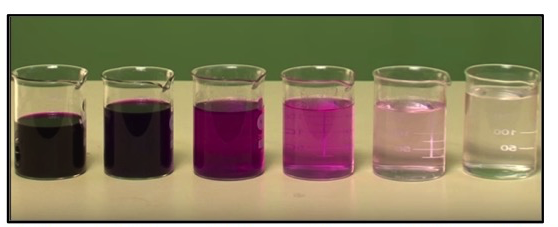
OBSERVATION
The process of dilution can continue until the solution appears colourless. This suggests that the particles of potassium permanganate are spread evenly on water.
As water particles increase, the particles of potassium permanganate are spread further, making the purple colourless and less until it appears colourless.
CONCLUSION
Potassium permanganate is made up of tiny particles.
Dissolving a Solid in a Solvent
- Put 100g of salt into the flask and add water carefully using a pipette without shaking the salt until it is full.
- Insert the stopper to the mouth of the flask and shake to dissolve the salt.
OBSERVATION
The volume of the solution of salt is less.
CONCLUSION
Particles of salt are able to occupy some spaces between the water particles. This suggests that the particles of salt differ in size.
The particles of the solution pack more closely in the available space, thus reducing the volume. This further suggests that particles of salt are broken down to fit into spaces between water particles.

Brownian Motion
This is the random movement of particles of a substance e.g. a gas or a liquid.
The particles are in a constant random motion.
Brownian Motion in Liquids
Experiment; To demonstrate the Brownian motion
Apparatus: Beaker, hand lens, chalk dust, transparent lid.
PROCEDURE
- Pour water into the beaker about 3/4 full as shown
- Sprinkle pollen grains or chalk dust on the surface of water (particles should be small in size, light and sprinkled evenly).
- Cover the beaker with a transparent lid and with the help of a hand lens observes what happens to pollen grains or chalk dust.
OBSERVATION
The pollen grains or chalk dust is in constant random motion.
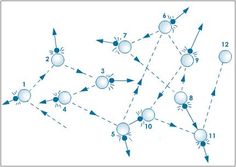
CONCLUSION
The particles are hit continually by the movement of small invisible particles of water. The movement is random, suggesting that the particles of water are in constant random movement.
This kind of movement is called Brownian motion a tribute to a scientist Robert Brown who first observed the effect.
Brownian Motion in Gases
The smoke cell experiment
Experiment: To demonstrate the Brownian motion in Air
Apparatus: Drinking straw, smoke cell, microscope and a bright light source
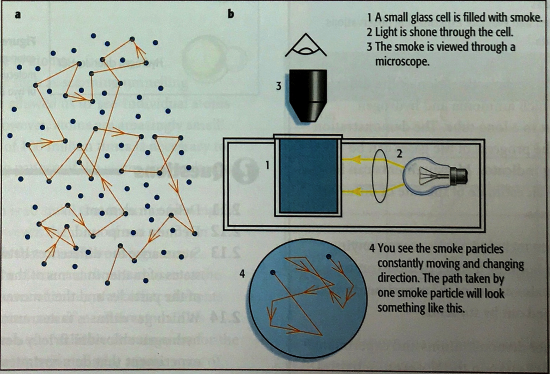
PROCEDURE
- Burn one end of the straw and let the smoke cell from the other end of the straw as shown above.
- Put a cover plate on top to seal the smoke and air in the cell.
- Illuminate the cell with bright light. Use a converging lens to focus the light to the smoke cell.
- Adjust the microscope until you see very bright specks against the grey background.
OBSERVATION
Bright specks are in continuous random motion are seen.
EXPLANATION
The bright specks are particles of smoke which scatter the light shining on them and appear as bright points. They move about in a continuous random movement because of uneven bombardment by the invisible particles or molecules in air. This suggests that air is made up of small particles which are in constant motion.
CONCLUSION
From the experiments above, matter is made up of very small particles which are in constant random motion. This is called kinetic theory of matter.

Arrangement of Particles in the States of Matter
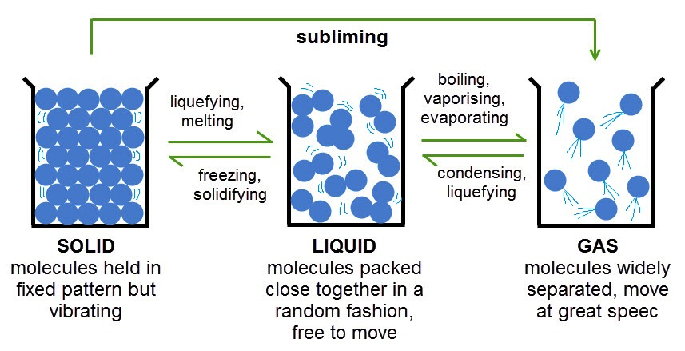
Solids
- The particles of solids are closely packed together in an organised way.
- The closely knit structure is due strong attractive forces (cohesive forces) between the particles.
- In their fixed positions, they vibrate to and from so that increasing the temperature of the solid increases this vibratory motion.
- At a certain temperature the solid breaks away from this knit structureand the solid is said to have melted.
Liquids
- The particles are further apart. They are not fixed as in solids but move about in Brownian motion.
- Liquids can break a solute put in it. Its easier to dissolve a solute in hot water because the particles have increased energy.
- The cohesive forces between the particles in liquids are weaker compared to those in solids. Due to this liquids can flow and take up the shape of the container in which they are put.
- When a liquid is heated molecules gain kinetic energy, they vibrate about and expand. The space between them widens further apart and the liquid changes into gaseous state by a process called vaporization.
Gases
- The particles are further apart and have increased random motion compared to those in the liquid state.
- The cohesive force between the particles is extremely small and as the particles move they collide with each other and with the walls of the container in which they are trapped. This produces gas pressure.
- Gases are easier to compress indicates that there exists a large intermolecular distance in gas than in liquids. Gas molecules or particles can lose some of their energy and fall back into the liquid state by a process known as condensation.
NOTE: Solids which when heated change directly into gas undergo the process called sublimation.

Diffusion
- This is the process by which particles spread from regions of high concentration to those of low concentration. Diffusion takes place in solids, liquids and gases.
- In solids, diffusion is exceedingly slow but occurs when two metals are placed in contact with each other e.g. lead and gold, metal block vibrating atoms breaks away from the substances to which they belong and enter the other substance to be trapped by its attractive forces. This process is speeded up by high temperature.
- Diffusion in liquids occurs at a faster rate than in solids.
- Diffusion in gases is faster due to their low density, high kinetic energy and weak cohesive forces.
Diffusion in Liquids
To investigate diffusion in liquids
Apparatus: pipette, beaker, copper (II) sulphate solution.
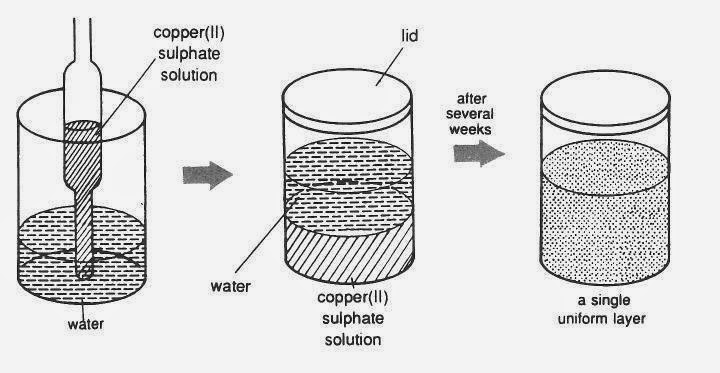
PROCEDURE
- Pour water into the beaker until it is half full.
- Pour saturated copper (II) sulphate solution using the pipette slowly and notice how the two liquids settle.
- Remove the pipette carefully so that the liquids are not disturbed.
- Repeat the same steps for another set of apparatus but using warm liquids. Make observation.
OBSERVATION AND EXPLANATION
- Initially, the water layer floats on top of the saturated copper (II) sulphate because it is less dense. After sometime, the boundary disappears and the liquids form a homogeneous pale blue mixture.
- Formation of the mixture is faster with hot liquids than because the movement of particles is faster due to increased energy. There is greater movement of water particles (molecules) from the water layer into copper (II) sulphate layer because it has greater concentration of water molecules than copper (II) sulphate particles.
- Similarly, there is a greater movement of particles from copper (II) sulphate layer into the water layer because of greater concentration of copper (II) sulphate particles than water molecules.
Diffusion in Gases
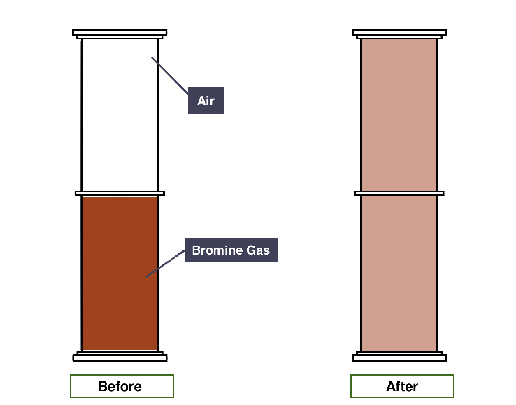
OBSERVATION AND EXPLANATION
- The bromine gas spreads into the gas jar B at a greater speed than it returns to gas jar A because of high concentration of bromine particles.
- Likewise, air spreads in gas jar A at a greater rate than it returns to gas jar B because of high concentration of air particles in B.
- A homogenous pale brown mixture forms in the two jars and because this happens in a very short time, it suggests that the random movement of particles is rapid (faster) than diffusion in liquids.
NOTE: Performing the same experiment with the jars held vertically instead of horizontally slows down the rate of diffusion because of the densities of the gases. The less dense gas diffuses much faster into the more dense gas.
Rates of Diffusion
To investigate the rates of diffusion of ammonium gas and hydrochloric gas
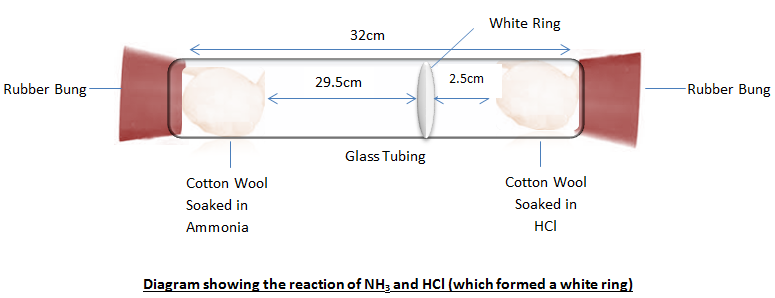
OBSERVATION AND EXPLANATION
- A white deposit of ammonium chloride forms on the walls of the glass tube in the region nearer end B. This suggests that ammonia gas diffused at a higher rate than hydraulic acid gas.
- Different gases have different rates of diffusion. A gas of high density has heavier particles hence moves more slowly than lighter one.
Diffusion through porous materials
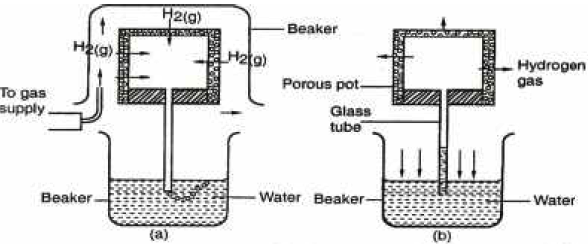
- The porous pot has very fine holes through which the hydrogen gas diffuses into the pot and air diffuses out.
- Hydrogen gas bubbles out of the glass tube as shown in the set up above.
- When the gas supply is stopped hydrogen gas diffuses out of the pot through the fine holes at a faster rate than air gets back to the pot. This decreases the gas pressure acting on the water surface in the beaker to push water up the tube.
NOTE: The beaker is used to confine the hydrogen gas around the porous pot.
QUESTION
- Describe the difference between solids, liquids and gases in terms of;
- Arrangement of particles/molecules.
- Distance separating molecules
- The movement of molecules
- Explain why rotten eggs broken at one end soon spreads the room.
Download PARTICULATE NATURE OF MATTER - Form 1 Physics Notes.
Tap Here to Download for 50/-
Get on WhatsApp for 50/-
Why download?
- ✔ To read offline at any time.
- ✔ To Print at your convenience
- ✔ Share Easily with Friends / Students